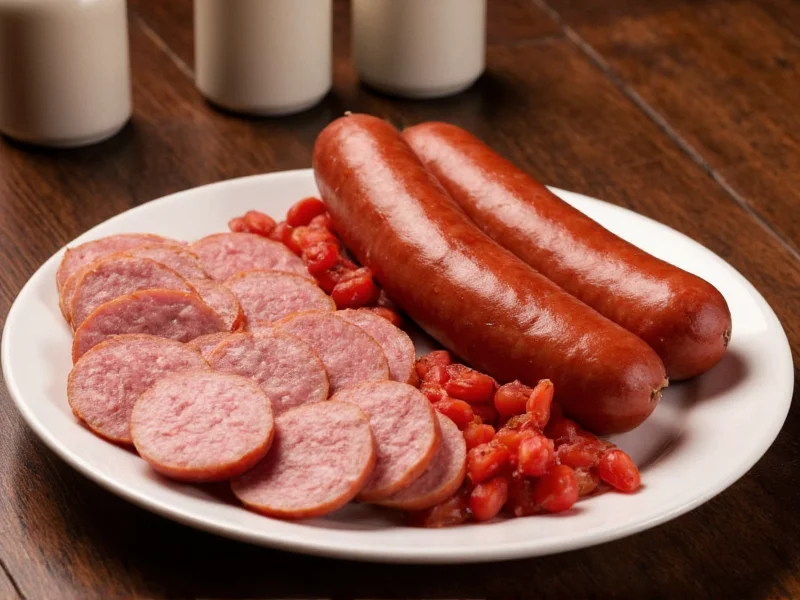Understanding the distinction between kielbasa and what's marketed as “Polish sausage” in the United States requires exploring linguistic roots, culinary traditions, and cultural adaptation. This guide clarifies the terminology confusion while providing practical insights for home cooks and food enthusiasts.
Linguistic Origins: What “Kielbasa” Really Means
The Polish word “kielbasa” (pronounced kel-BAH-sa) translates directly to “sausage” in English. In Poland, this term serves as an umbrella category for numerous traditional sausage varieties, much like “cheese” encompasses cheddar, brie, and gouda in English. When Polish immigrants arrived in America during the late 19th and early 20th centuries, they brought their sausage-making traditions but adapted recipes to available ingredients and local tastes.
American grocery stores simplified this diversity by labeling the most popular smoked variety as “Polish sausage,” creating the misconception that kielbasa and Polish sausage are distinct products. In reality, all Polish sausages are kielbasa, but not all kielbasa matches the American interpretation of “Polish sausage.”
Traditional Polish Kielbasa Varieties vs. American “Polish Sausage”
Poland recognizes over 40 protected regional kielbasa varieties under the European Union's Traditional Speciality Guaranteed (TSG) program. The American version represents just one interpretation of these traditions. Here's how they compare:
| Characteristic | Traditional Polish Kielbasa | American “Polish Sausage” |
|---|---|---|
| Primary Ingredients | Pork (sometimes beef or poultry), garlic, marjoram, pepper | Pork, garlic, smoke flavoring, higher fat content |
| Preparation Method | Fresh or smoked, often air-dried (wiejska), boiled (biała) | Always smoked, pre-cooked, often sold in U-shape |
| Texture | Firmer, coarser grind, visible meat chunks | Softer, finer emulsion, smoother texture |
| Flavor Profile | Complex herbal notes, subtle smoke, pronounced garlic | Dominant smoke flavor, milder seasoning, sweeter profile |
| Cooking Requirement | Many varieties require cooking (except smoked/dried) | Pre-cooked, typically just needs reheating |
Common Polish Kielbasa Types You Should Know
Understanding authentic Polish sausage varieties helps clarify why the American version represents just one interpretation:
- Kielbasa Krakowska: A protected variety from Krakow made with coarse-ground pork, garlic, and black pepper, air-dried for 2-3 weeks
- Kielbasa Biała (White Sausage): Fresh, unsmoked sausage traditionally served with sauerkraut and mustard for breakfast
- Kielbasa Wiejska (Country Sausage): Coarsely ground with visible meat chunks, heavily seasoned with garlic and marjoram
- Kielbasa Lisiecka: A protected Podkarpackie region specialty with distinctive horseshoe shape and juniper notes
Why the American Version Differs
Several factors shaped the American interpretation of Polish sausage:
- Ingredient availability: Polish immigrants substituted traditional spices with locally available ingredients
- Industrial production: Commercial manufacturers modified recipes for mass production and longer shelf life
- Smoke flavoring: Many American versions use liquid smoke instead of traditional wood smoking
- Sweetness adaptation: American palates influenced the addition of sugar and milder seasoning
Authentic Polish kielbasa typically contains only meat, fat, salt, garlic, and traditional spices like marjoram and black pepper—no fillers, sugar, or artificial smoke flavoring. The European Union protects several Polish sausage varieties under its Traditional Speciality Guaranteed program, requiring specific production methods and ingredients.
Shopping Tips for Authentic Products
When seeking genuine Polish sausage experiences:
- Look for products labeled with specific Polish names (Kielbasa Wiejska, Kielbasa Krakowska) rather than generic “Polish sausage”
- Check ingredient lists for artificial smoke, sugar, or fillers which indicate American-style production
- Seek Polish-owned butcher shops or specialty markets for traditional varieties
- Understand that fresh kielbasa (biała) requires cooking, while smoked varieties (wiejska) are often ready-to-eat
Culinary Applications: Traditional vs. American Styles
Both versions have distinct culinary uses:
Traditional Polish preparations often feature kielbasa in dishes like bigos (hunter's stew), served with sauerkraut and rye bread, or grilled simply with mustard. Fresh biała is traditionally boiled and served for breakfast with fried onions.
American-style “Polish sausage” commonly appears at cookouts, sliced in sandwiches, or served with pierogi. Its pre-cooked nature makes it convenient for quick meals, though it lacks the nuanced flavor of authentic varieties.
Cooking Techniques for Best Results
To maximize flavor whether using traditional or American-style products:
- Traditional kielbasa: Grill over medium heat for 10-12 minutes, turning frequently. Avoid high heat which can cause casing to burst
- American-style sausage: Simmer in beer with onions for 15 minutes before grilling to enhance flavor and moisture
- Never pierce sausages while cooking—this releases flavorful juices
- Rest for 5 minutes after cooking before slicing to retain juices











 浙公网安备
33010002000092号
浙公网安备
33010002000092号 浙B2-20120091-4
浙B2-20120091-4